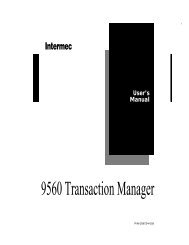Contents, cont'd. - Intermec
Contents, cont'd. - Intermec
Contents, cont'd. - Intermec
Create successful ePaper yourself
Turn your PDF publications into a flip-book with our unique Google optimized e-Paper software.
Chapter 3 Image Transfer<br />
Image Format The following image format is valid for Intelhex, UBI00, UBI01, UBI02 and<br />
UBI03 image transfer protocols, but not for the UBI10 protocol, which is a<br />
combined image transfer protocol and format.<br />
A bitmap picture can be encoded in one of two ways, as a plain bit<br />
representation or encoded with a Run Lenght Limited (RLL) algoritm.<br />
Pictures can be magnified, by the printer, up to four times independently in<br />
both x and y directions.<br />
The pictures can be rotated 180 degres by the printer (i.e. printed upsidedown).<br />
To print a bitmap in all four directions you have to define two bitmaps, one<br />
straight and one rotated 90 degrees. To comply with the <strong>Intermec</strong> Fingerprint<br />
convention, use the extension .1 for the straight bitmap and extension .2 for<br />
the rotated one.<br />
Bitmap pictures, in both encoding schemes, are printed with the lowest<br />
address first, i.e. first row of defined data is the first thing out. (This may be<br />
somewhat confusing. The only result, if you missinterpretate this, is that your<br />
picture will come out upside down.)<br />
Bitmap pattern, bit representation<br />
The bitmap picture is encoded word oriented (i.e. 16 bits), low byte first. The<br />
bits in each byte is read from lsb first (i.e. bit 0).<br />
Bitmap pattern, Run Lenght Limited (RLL)<br />
RLL encoding is a very efficient way of compressing big bitmaps with<br />
relatively big black and/or white areas.<br />
The RLL encoded picture is encoded byte oriented (i.e. 8 bits). Each byte<br />
represents the number of consecutive black or white dots. The sum of bytes<br />
for each row must equal the width of the pattern. The first byte represent white<br />
dots, the second black and so on. The last byte must alter the color back to<br />
white. If the first dot is black just enter a zero first. Valid values for dot fields<br />
is 0...127 (0..7f hex). To get a row longer then 127, concatenate two rows with<br />
zero, e.g. to get a row of 240 dots, enter 128,0,112.<br />
The next step in our RLL encoding algoritm is to compress identicals rows,<br />
two identical rows are compressed by adding a byte in both ends of the dot<br />
row, the valid range for these bytes are -1...-128 (ff..80 hex).<br />
<strong>Intermec</strong> Fingerprint 7.2 – Reference Manual Ed. 3 246
















